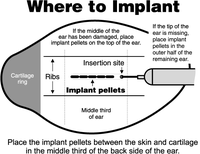Consider Implants for Suckling Calves
(Click the image below to view a high-resolution image that can be downloaded)
Growth-promoting implants are one tool livestock producers have to help optimize their cattle’s performance and enhance productivity.
Implants are small pellets applied to the middle third of the back of the ear. A variety of implant products are designed for use during the nursing, growing and finishing stages in beef cattle production. They contain naturally occurring or synthetic hormones that increase the efficiency of feed use and stimulate muscle growth.
Implants first were approved for use in the 1950s. However, cow-calf producers have not adopted this practice widely for a variety of reasons, including misinformation and confusion about the products, personal beliefs or consumer concerns related to hormone levels in beef, and management or marketing strategies.
“All growth-promoting implants are approved and regulated by the U.S. Food and Drug Administration and have been shown to be safe for livestock and also for humans consuming meat from animals that have received implants,” says Janna Kincheloe, the North Dakota State University Extension Service’s area livestock systems specialist at the Hettinger Research Extension Center.
Some producers receive a premium for not using implants by marketing their cattle through natural or organic channels. However, producers who sell calves through traditional methods at weaning without using an implant are forfeiting an estimated 3 to 5 percent gain in weaning weight and a $15 to $20 return for every dollar spent on implants, she notes.
Branding season is a potential opportunity to implant using a product labeled specifically for nursing calves. Most implant products are designed for a certain sex and age. None of the available products are to be used in cattle less than 30 to 45 days old.
The estimated effective period for most of the nursing calf implants is about 120 days, which could mean that implants are utilized completely several months prior to weaning. Re-implanting prior to weaning may or may not be cost-effective, depending on the type of implant used and the potential to offset application costs through moderate additional gains. Typically, only one implant is recommended, depending on the age of calves and the marketing date.
Kincheloe says another important factor about implants is that they will not increase weight gain if nutrition is inadequate. Therefore, producers need to determine that milk production and access to high-quality forage are adequate. If facilities are available, one option is to offer creep feed to calves to increase implant response.
Due to potential negative impacts on reproductive performance, implants are not intended for use in bull calves that will be used for breeding or in heifers that have been identified as replacements. However, many producers have not made their final selections for their replacement heifers by branding time.
Research indicates that heifers may be implanted once between 45 days and 3 months of age to improve weaning weight with minimal impacts on reproduction. If producers choose this strategy, using a moderate product designed for suckling heifers is important to minimize losses in future reproductive performance, according to Kincheloe.
“Proper handling and placement of implants is extremely important to get an optimal response,” says Lisa Pederson, NDSU Extension’s beef quality specialist. “This is not a job that should be handed off to the least experienced person on the branding crew.”
She has this advice for producers who plan to use implants:
- Restrain the calf properly to make sure the implant is applied correctly and reduce the risk of injury to animals and people.
- Make sure ears are free of dirt and manure, and disinfect them if possible, before applying the implant.
- Use the appropriate implant gun for the type of implant being used.
- Make sure the needle is sharp and tightly secured to the implant gun.
- Clean the needle with a disinfectant between animals.
- Place the implant between the skin and cartilage in the middle third of the back side of the ear. Withdraw the implant gun as the implant is applied to make space for the pellets.
- Do not place the implant into the cartilage because it will not be absorbed. Applicators should be able to see and feel the implant if it has been placed correctly.
“The use of growth-promoting implants at branding is an effective, cost-efficient method to improve weaning weights,” Kincheloe says. “It is important to choose the appropriate product and follow manufacturer directions carefully to get an optimal response.”
For more information about implants, contact your county office of the NDSU Extension Service or veterinarian.
NDSU Agriculture Communication - May 16, 2017
| Source: | Janna Kincheloe, 701-567-4323, janna.kincheloe@ndsu.edu |
|---|---|
| Editor: | Ellen Crawford, 701-231-5391, ellen.crawford@ndsu.edu |
Attachments
- PDF - Where to Implant: Place the implant pellets between the skin and cartilage in the middle third of the back side of the ear. - (394.2021484375 kb)
- EPS - Where to Implant: Place the implant pellets between the skin and cartilage in the middle third of the back side of the ear. - (480.1513671875 kb)


